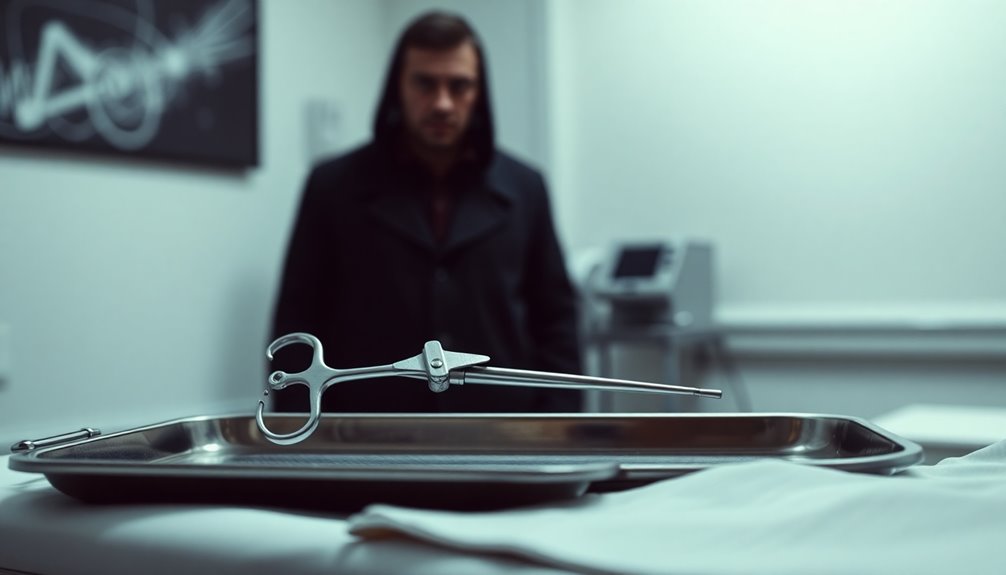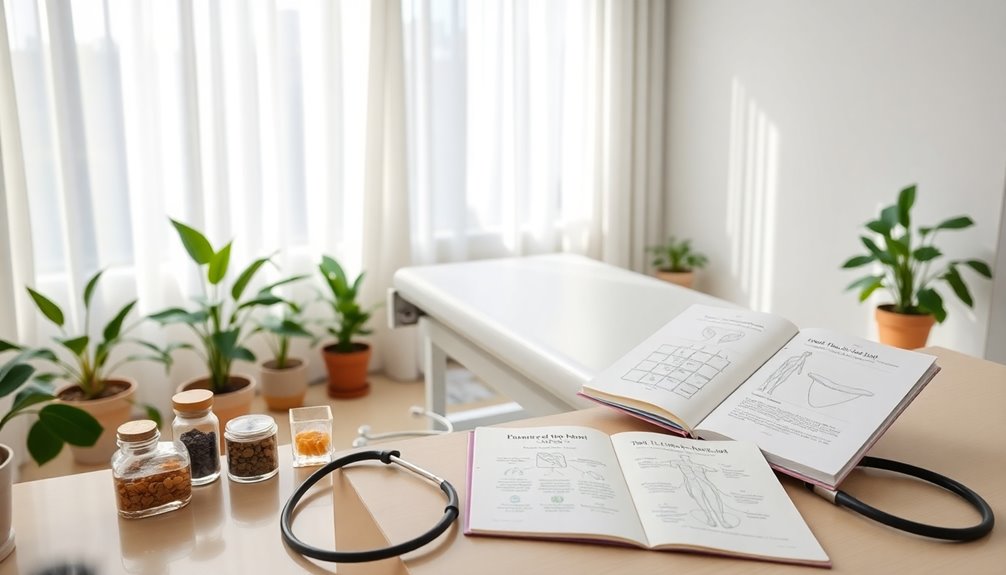If you're considering a D&C, you should know there are potential risks and complications involved. These include heavy bleeding, infection, and even perforation of the uterus. Additionally, Asherman's syndrome might develop, which can impact future fertility. Emotional distress is also common post-procedure. It's essential to weigh these risks carefully and discuss them with your healthcare provider. To understand more about D&C and its alternatives, keep exploring the available information.
Key Takeaways
- Heavy bleeding occurs in 1-5% of patients post-D&C, potentially requiring further medical intervention.
- Infection risks range from 1-2%, necessitating immediate treatment for symptoms like fever.
- Uterine perforation, while rare, affects approximately 1 in 1,000 procedures, leading to serious complications.
- Asherman's syndrome, occurring in 1-2% of cases, can result in future fertility issues due to scar tissue formation.
- Emotional distress, including anxiety and depression, may develop after the procedure, requiring support and counseling.
Understanding Dilation and Curettage (D&C)

When you undergo dilation and curettage (D&C), you're participating in a surgical procedure designed to address various uterine issues.
This procedure involves the dilation of your cervix and scraping of the uterine lining to remove tissue for diagnostic or therapeutic purposes. It's often performed after a miscarriage to clear retained tissue or to investigate abnormal uterine bleeding.
Typically, a healthcare provider conducts the D&C under anesthesia, and it lasts about 5-10 minutes. While most experience mild cramping and spotting afterward, they can usually resume normal activities within a few days.
However, like any medical procedure, D&C carries risks, including infection or injury, which you should discuss with your healthcare provider to guarantee you understand all aspects involved.
Common Reasons for D&C Procedures

Dilation and curettage (D&C) is performed for several key reasons that address various uterine health concerns.
Many women undergo D&C to diagnose and treat abnormal uterine bleeding, often caused by conditions like uterine fibroids or polyps.
D&C is commonly performed to diagnose and treat abnormal uterine bleeding due to fibroids or polyps.
It's also used to remove retained tissue after a miscarriage or abortion, preventing complications such as heavy bleeding and infection.
For those experiencing postmenopausal bleeding, D&C serves diagnostic purposes to rule out serious conditions, including uterine cancer through tissue sampling.
Additionally, this outpatient procedure can clear infected tissue in cases of pelvic inflammatory disease (PID) or help in removing intrauterine devices (IUDs).
Understanding these reasons can help you make informed decisions about your uterine health.
The D&C Procedure: What to Expect

When you undergo a D&C, you can expect a brief procedure that typically lasts about 5-10 minutes.
You'll have options for anesthesia, which may include general, regional, or local.
Afterward, recovery usually takes a few days, but emotional healing might take a bit longer, especially if you're dealing with a miscarriage.
Procedure Overview
As you prepare for a dilation and curettage (D&C) procedure, it's helpful to know what to expect.
This minor surgical procedure typically lasts about 5-10 minutes, though you'll need extra time for anesthesia and recovery monitoring.
Your healthcare providers will start by inserting a speculum to visualize your cervix, then use dilators to open it before scraping the uterine lining with a curette.
While D&C can provide tissue samples for testing, be aware of potential risks, such as excessive bleeding.
You'll usually recover in an outpatient setting and can go home the same day.
Remember to arrange transportation, as you'll need time for emotional recovery before returning to normal activities, typically within several days.
Anesthesia Options
After understanding the procedure overview, it's important to evaluate the anesthesia options available for your D&C.
Your choice will depend on factors like patient health, procedure complexity, and your healthcare provider's recommendation.
Here are the main anesthesia options:
- General Anesthesia: You'll be unconscious during the procedure, which may require longer recovery time.
- Regional Anesthesia: This numbs the lower body, allowing you to rest but still requiring transportation home due to impaired motor skills.
- Local Anesthesia: Only the cervix is numbed, letting you stay awake and usually resulting in less recovery time.
- Considerations: Always discuss your options with your healthcare provider to guarantee the best choice for your situation.
Recovery Expectations
Understanding what to expect during recovery from a D&C can help ease anxiety and prepare you for the days ahead.
After your time in the recovery room, you'll likely experience mild cramping and light bleeding for a few days. Most people can resume normal activities within a week, using over-the-counter pain relief as needed.
It's essential to avoid vaginal insertion and tampons for at least two weeks to reduce the risk of infection. A follow-up appointment is typically scheduled within two weeks to monitor your recovery.
Potential Risks and Complications

While undergoing a dilation and curettage (D&C) procedure can be necessary for various medical reasons, it's essential to be aware of the potential risks and complications involved.
Here are some key concerns:
- Heavy bleeding: Occurs in about 1-5% of patients, which may require further medical intervention.
- Infection: There's a risk of infection around 1-2%, necessitating prompt treatment if symptoms appear.
- Uterine perforation: A rare complication occurring in roughly 1 in 1,000 procedures, potentially damaging surrounding organs and needing surgical repair.
- Asherman's syndrome: Can develop in 1-2% of cases, leading to scar tissue that may impact future fertility.
Being informed about these risks helps you prepare for potential complications after a D&C procedure.
Emotional Impact of D&C

Experiencing a D&C can bring up intense feelings of loss, anxiety, and depression, especially if you've faced a miscarriage.
You might find yourself juggling the urge to move on while needing time to grieve, making emotional healing challenging.
It's vital to recognize these feelings and seek support from friends, family, or professionals who understand what you're going through.
Coping With Loss
Coping with the emotional aftermath of a D&C can be incredibly challenging, especially after a miscarriage. You might feel a mix of grief and anxiety as you navigate your loss.
It's crucial to seek emotional support during this difficult time. Consider these options:
- Counseling options: Professional help can guide you through your feelings.
- Support groups: Connecting with individuals who've experienced similar losses can foster healing.
- Open communication: Talk with your partner or friends about your feelings.
- Self-care: Prioritize activities that nurture your mental health.
Anxiety and Depression
The emotional turbulence following a D&C can lead many individuals into a challenging landscape of anxiety and depression. Experiencing a miscarriage can trigger considerable emotional distress, with studies showing that up to 20% may develop serious anxiety or depression afterward.
The grieving process often feels cumbersome, complicated by the physical recovery needed post-procedure. For effective emotional recovery, counseling and support networks become essential, allowing you to share experiences and process your grief. Engaging in mindfulness and relaxation techniques can also help manage the emotional impact during this difficult time.
It's crucial for healthcare providers to recognize these emotional challenges and offer thorough support during this time. Remember, you're not alone; many face similar struggles, and seeking help can greatly ease the burden of anxiety and depression.
Support Systems Needed
While maneuvering through the emotional aftermath of a D&C, having a solid support system can make all the difference.
The emotional impact of a miscarriage can leave you feeling lost and overwhelmed. Here are some essential support resources to reflect on:
- Counseling: Professional help can guide you through your grief and offer coping strategies.
- Care Teams: Reach out to your healthcare providers; they can offer valuable support and information.
- Support Groups: Connecting with individuals who've faced similar losses can foster healing and understanding.
- Community Events: Participating in events focused on grief can help you feel less isolated.
Additionally, understanding the importance of emotional dysregulation in processing grief can provide insights into your emotional responses during this challenging time.
These resources are crucial for your emotional well-being as you navigate the complex journey of healing from loss.
Recovery Process After D&C

Recovering from a D&C can be a straightforward process if you follow your doctor's instructions.
The recovery process typically lasts two to four weeks, with most patients returning home within a few hours post-surgery. You might experience light bleeding or spotting, so use pads instead of tampons for at least two weeks.
Pain management is important, and over-the-counter pain relievers can help with discomfort. Be sure to attend follow-up appointments within two weeks to monitor your recovery and catch any potential complications early.
It's essential to avoid vaginal intercourse and tampons during this time to guarantee proper healing.
When to Seek Medical Attention

Following a D&C, it's important to monitor your recovery closely and be aware of any concerning symptoms. If you notice any of the following, don't hesitate to reach out to your healthcare provider:
- Fever: A temperature over 100.4°F may indicate an infection.
- Excessive bleeding: Changing a pad every hour or passing large clots requires immediate attention.
- Cramping: Persistent or worsening cramps that aren't relieved by over-the-counter pain medication could signal complications.
- Emotional distress: If you're feeling prolonged sadness or anxiety, seek support and potential counseling.
Address any menstrual cycle irregularities or questions regarding recovery timelines with your doctor to guarantee a smooth healing process.
Prompt medical evaluation is vital for your well-being.
Alternatives to D&C

If you're looking for options other than a D&C, several alternatives can effectively address your needs. Here are some options to evaluate:
| Alternative | Description | Best For |
|---|---|---|
| Medication Management | Hormonal treatments or misoprostol help expel retained tissue naturally. | Early miscarriage, abortion |
| Vacuum Aspiration | A less invasive procedure that can diagnose and treat uterine conditions. | Retained tissue, irregular bleeding |
| Hysteroscopy | Provides direct visualization of the uterine cavity for accurate diagnosis. | Polyps, fibroids |
Additionally, "watchful waiting" allows some cases to resolve naturally without intervention. If you're weighing alternatives to D&C, discuss these options with your healthcare provider.
Frequently Asked Questions
What Are the Risks of a Curettage?
Curettage carries several risks you should be aware of.
You might face uterine perforation, occurring in about 1-3% of cases, which could require surgery.
There's also a risk of infection, estimated at 1-2%, especially if tissue remains.
Heavy bleeding is possible, possibly leading to transfusions.
Additionally, you could develop Asherman's syndrome, affecting future fertility, and emotional distress is common, particularly if the procedure followed a miscarriage.
What Is the Most Common Complication of Curettage?
When you consider curettage, it's essential to know what could go wrong. The most common complication you might face is heavy bleeding, occurring in about 1-2% of cases. This can be alarming, especially right after the procedure.
You should also be aware of other risks, like infection or cervical laceration, which can complicate your recovery. Staying informed helps you prepare and discuss any concerns with your healthcare provider effectively.
Is It Safe to Have a Curettage?
Dilation and curettage (D&C) is generally regarded as safe for many patients, but it isn't without risks.
You might face complications like uterine perforation, infection, or heavy bleeding. While these are rare, they're important to take into account.
Additionally, emotional distress can accompany the procedure, especially after a miscarriage.
It's crucial to discuss any concerns with your healthcare provider, as they'll help you weigh the benefits against potential risks tailored to your situation.
How Long Does It Take to Recover From Curettage?
Recovery from curettage usually takes about two to four weeks.
You can often return to normal activities within five days, but it's important to listen to your body.
Expect some light bleeding or spotting afterward, and avoid tampons and sexual intercourse for at least two weeks.
Pain management is key, so over-the-counter medications like ibuprofen can help with cramping.
Don't forget to schedule a follow-up appointment to check on your recovery.
Conclusion
In summary, while dilation and curettage (D&C) can be necessary, it's essential to weigh the risks and emotional impact. For instance, Sarah underwent a D&C after a miscarriage. While the procedure helped her physically, she struggled emotionally for months afterward. Always consult your doctor about your options and potential complications. Remember, understanding the process and its effects can empower you to make informed decisions about your health and well-being.









